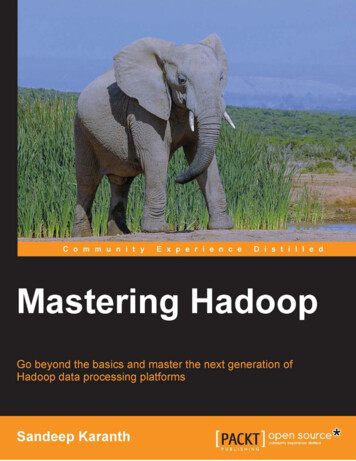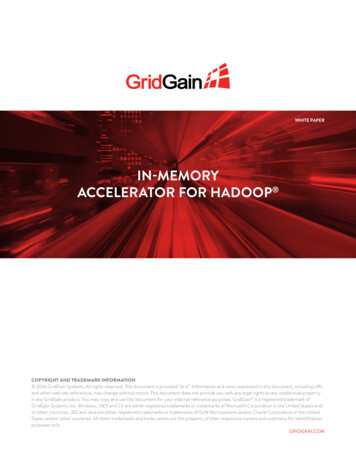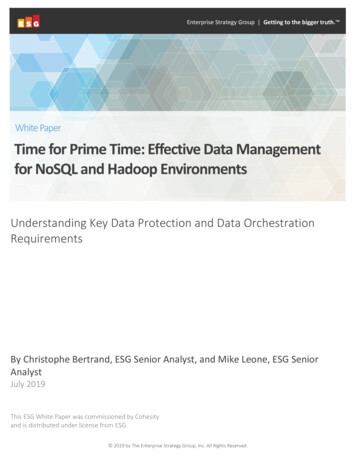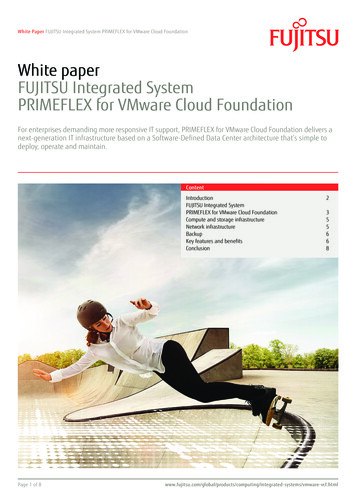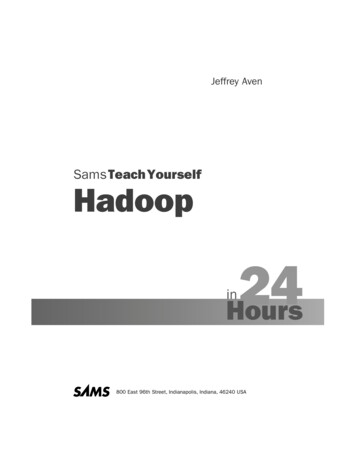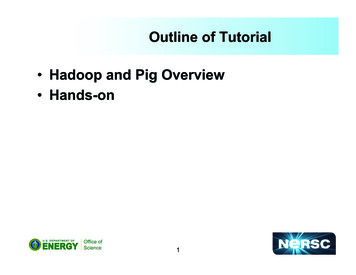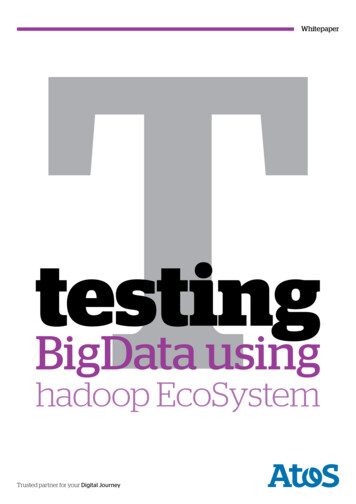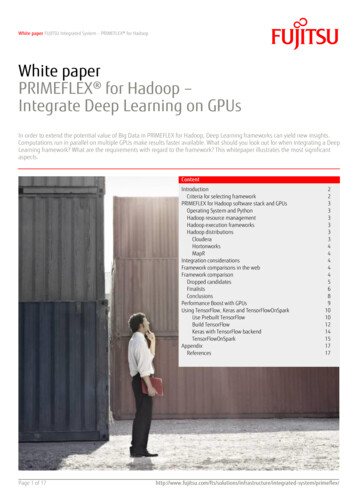
Transcription
White paper FUJITSU Integrated System – PRIMEFLEX for HadoopWhite paperPRIMEFLEX for Hadoop –Integrate Deep Learning on GPUsIn order to extend the potential value of Big Data in PRIMEFLEX for Hadoop, Deep Learning frameworks can yield new insights.Computations run in parallel on multiple GPUs make results faster available. What should you look out for when integrating a DeepLearning framework? What are the requirements with regard to the framework? This whitepaper illustrates the most significantaspects.ContentIntroductionCriteria for selecting frameworkPRIMEFLEX for Hadoop software stack and GPUsOperating System and PythonHadoop resource managementHadoop execution frameworksHadoop distributionsClouderaHortonworksMapRIntegration considerationsFramework comparisons in the webFramework comparisonDropped candidatesFinalistsConclusionsPerformance Boost with GPUsUsing TensorFlow, Keras and TensorFlowOnSparkUse Prebuilt TensorFlowBuild TensorFlowKeras with TensorFlow backendTensorFlowOnSparkAppendixReferencesPage 1 of em/primeflex/
White paper Fujitsu Integrated System - PRIMEFLEX for HadoopIntroductionThis document explains available Deep Learning frameworks for applicability of parallel GPU support on PRIMEFLEX for Hadoop. It contains ashort framework comparison and provides instructions for selected frameworks.What is the difference between CPUs and GPUs? A CPU is a general purpose processing unit with a few powerful cores where each onesequentially processes a different task. The first generation of GPUs were special purpose processing units for graphic related tasks. GPUs haveevolved, and now they are general purpose graphical processing units (GPGPU) which contain thousands of small cores which are able to worktogether for processing parallel workloads efficiently, not only in graphics but also in other areas requiring massive parallel computations. Thus,GPUs are purpose-built for efficiently handling parallel workloads.When to use GPUs? GPUs are best suited for compute-intensive massive parallel tasks. The training process for neural networks in Deep Learningframeworks is such an example. In big data analytics environments, GPU-enabled software allows making real-time business decisions. Inengineering and structural mechanics applications profit from using the power of GPUs.What does “parallel GPU support” mean? Deep Learning frameworks have evolved to more and more harness the thousands of cores in generalpurpose GPUs in order to speed up their compute intensive work while training a neural network. As of today, many frameworks support at leasta single GPU. This feature requires explicitly offloading the execution of compute-intensive programming steps together with the data for thatstep to a GPU. Frameworks either automatically achieve this, which is more user friendly but less flexible, or expect the user or developer tospecify the binding. The next stages are parallel use of multiple GPUs on the same server and distributed use on multiple servers. The advantageof having more GPUs at hand for the calculations comes with the drawback that more data transfers between CPUs and GPUs – on the sameserver or over the network – are necessary for consolidating intermediate results.This paper focuses on NVIDIA GPU cards which are optionally available for PRIMEFLEX for Hadoop as AI-node component. NVIDIA provides theCUDA Toolkit which includes a large set of components for developing and running GPU-accelerated applications. The toolkit comprises a set ofC/C GPU-accelerated libraries for Linear Algebra and Mathematics, Deep Learning, Parallel Algorithms, etc. Deep Learning frameworks usethese libraries for accessing the GPUs.Criteria for selecting frameworkThe search for suitable frameworks concentrated on the following filter criteria:Collaboration with PRIMEFLEX for Hadoopo Execution on Data NodesPreferably common resource management for components of PRIMEFLEX for Hadoop and Deep Learning frameworko Execution on Edge NodesCombined workflows with PRIMEFLEX for Hadoop require data exchange, e.g. via HDFSProgramming interfaceo Widely spread in AI: traditional data scientists are accustomed to Python or Ro Already provided by the PRIMEFLEX for Hadoop software stack, Python preferred, but also Scala or Java APISimple installation (no or easy building of framework, required dependencies easy to fulfill)Amount and quality of examples included with the frameworkEasy and fast testing during developmentSimple switch from CPU-bound application to GPU-boundo Either framework automatically decides which code shall be offloaded to the GPUo Or application specifies the amount of GPUs neededo Or few code changes to bind code or data to GPU(s)Support by a large and active communityMaturity and with a promising futureVisualization of static information, e.g. network layer, and dynamic information, e.g. training progressLicenseo Restrict to Open Source Software for Deep Learning in first studyThe following criteria may also be applied during the search but have not been taken into consideration in this version of the paper:Programming interfaceo High-level tools: probably more comfortable for non-technical usersSupported deep learning functionalitySupported model file formats for exchange with other frameworksGood performanceDocumentation for administration and developmentLicense / Priceo Scan commercial productsPage 2 of ure/integrated-system/primeflex/
White paper Fujitsu Integrated System - PRIMEFLEX for HadoopPRIMEFLEX for Hadoop software stack and GPUsA good starting point for the framework search are the components of PRIMEFLEX for Hadoop which is currently based on RHEL7 and supportsCloudera, Hortonworks and MapR Hadoop distributions. All three distributions contain YARN as cluster-wide resource management andMapReduce and Spark as execution frameworks. This chapter presents what YARN, Spark, MapReduce and the distribution vendors say aboutGPU support and which Deep Learning frameworks they think are worth mentioning on their web pages.Operating System and PythonMany Deep Learning frameworks are based on python and, apart from the basic python components, may require additional python modules oroperating system packages. The easiest way to install python is as an operating system package. But this way may imply some restrictionsconcerning the exact python version and thus the available python modules, especially the availability of ready to use GPU enabled modules forDeep Learning frameworks. PRIMEFLEX for Hadoop comes with RHEL7 and python version 2 installed.Hadoop resource managementYARN is the central resource management instance for applications in Hadoop clusters handling allocation of CPUs and memory. Starting withApache Hadoop version 3.0, YARN supports an extensible resource model that can be enhanced for also managing GPUs. Hadoop distributionsare still in the process of adapting to this major release.Hadoop versions less than 3.0 offer several workarounds overcoming scheduling problems for GPU-utilizing jobs, as pointed out by theDeepLearning4j web page [1]:---Node labels are a useful feature already available in YARN (versions 2.6 or greater) which provide a way for grouping nodes withsimilar characteristics, and applications can specify on which group of nodes to run. This feature can be used to distinguish betweennodes with and without GPUs. The Cloudera Hadoop distribution does not support nodel labels, considering them not yet ready, see[2]. Node labels do not prevent YARN from trying to run multiple GPU-utilizing tasks on the same node if their CPU and memoryrequirements can be fulfilled on that node.Allocating sufficient memory and cores to the GPU-utilizing tasks ensures that YARN will not schedule other tasks on the same nodes. Incombination with the node label, this solution will reserve the GPU node or nodes for exclusive use by a single GPU-utilizing task. Thisapproach avoids concurrent access to GPUs, but wastes resources.Using the Docker Container Executor (DCE) for YARN jobs allows GPU resource management via docker. If the GPU is declared as beingused in the docker container, then this ensures that the GPU is not allocated to multiple tasks. The docker container nvidia-dockerimplicitly handles this declaration. By default, YARN uses the Linux Container Executor(LCE) for executing the tasks of a job directly ontop of the native operating system. With Hadoop versions 2.x, there can only be one type of container executor active in the cluster,either all YARN jobs run via LCE or via DCE. Cloudera recommends waiting for Hadoop 3.0 before deploying Docker containers, citingsecurity issues and other caveats in the article [3]. In Hadoop version 3.0, LCE is able to run tasks on the native operating system andtasks in docker containers in parallel.Hadoop execution frameworksSpark provides basic machine learning functionality in its libraries MLlib and ML, thus offloading of computations to GPUs is a subject that hasalready arisen, but change requests are still open or not fixed, see [4]. Some established Deep Learning frameworks have inspired projects forrunning them in a distributed way on Spark. Examples are CaffeOnSpark and TensorFlowOnSpark or TensorFrames.MapReduce will not be used as a starting point in the search for suitable Deep Learning frameworks as it does not include any machine learningfunctionality and has been superseded by Spark as a leading Hadoop execution framework.Hadoop distributionsClouderaCloudera’s website and community posts referencing GPUs mainly demonstrate how to use Deep Learning frameworks on the Cloudera DataScience Workbench (CDSW):Caffe/CaffeOnSpark, TensorFlow/TensorFlowOnSpark, Deeplearning4j on the CDSW [5]Deeplearning4j with a Scala example [6]TensorFlow, Keras and Theano [7]Cloudera plans to adapt their platform to Apache Hadoop version 3 features in 2018.The current version of PRIMEFLEX for Hadoop supports optional nodes (AI Node) with GPUs which run the CDSW.The CDSW supports parallel GPU utilization on a single server as described in [8]:By enabling GPU support, data scientists can share GPU resources available on CDSW nodes. Users can request a specific number of GPU instances,up to the total number available on a node, which are then allocated to the running session or job for the duration of the run.There is currently no documentation for GPU-utilizing jobs distributed over several nodes which have been installed with the CDSW.Page 3 of ure/integrated-system/primeflex/
White paper Fujitsu Integrated System - PRIMEFLEX for HadoopHortonworksHortonworks website and Hortonworks slides on slideshare point to:A blog showing distributed TensorFlow on YARN using nvidia-docker [9]A community entry for setting up Deeplearning4j with Apache Spark and an HDP cluster on AWS [10]The Hortonworks platform may be the one which is closely linked with open source Hadoop, but there is apparently no public roadmap orplanned release date for an HDP version based on Apache Hadoop version 3 and thus including the latest YARN resource model which canprovide GPU support.MapRMapR’s website references GPUs in:A blog entry demonstrating how to use Caffe and CaffeOnSpark in YARN cluster mode, but without test of GPU integration [11]An example with distributed TensorFlow on Kubernetes requiring manual steps to start worker pods [12]There is currently no publicly available information about when MapR will adapt to Apache Hadoop version 3 features.Integration considerationsIntegrating a GPU-utilizing framework with PRIMEFLEX for Hadoop can be achieved in several ways:-Setting up the framework on a node with read and write access to the HDFS for data exchange with PRIMEFLEX for HadoopRunning the framework jobs on the Data Nodes of the Hadoop clusterThe first integration solution can be achieved for the Cloudera Hadoop distribution by installing a node with GPUs, the CDSW and the HDFSgateway service. This solution is suitable for those frameworks that have APIs in programming languages supported by the CDSW, i.e. Python, Rand Scala. For other programming languages or other Hadoop distributions, a framework can be set up on any computer with access to theHDFS, even a Windows PC or notebook.The second integration solution can be achieved by running the framework jobs in parallel to the Hadoop YARN jobs on the Data Nodes, but thissolution will require static division of resources such as CPU or memory between the framework and YARN jobs. This solution will not make gooduse of the resources. If the framework jobs shall be run on the Hadoop cluster, then the best solution is to run them via YARN.PRIMEFLEX for Hadoop does not yet support GPUs on Data Nodes as the supported distributions do not yet provide suitable handling for GPUs inYARN. Hadoop distributions will adapt to newer versions of YARN with GPU support in the near future. Thus, looking ahead, this documentassesses deep learning frameworks supporting distributed GPU computing on YARN.Framework comparisons in the webThere are several web sites with comparisons of Deep Learning frameworks.Wikipedia provides a comparison table for Deep Learning software including information about NVIDIA CUDA support for GPUs and parallelexecution (multi node) at [15].Skymind compare their software DeepLearning4j with other frameworks at [16].The article [13] from March 2016 compares Caffe, TensorFlow, Theano, Torch and Neon with focus on single server setups.There is another article [14] from February 2017 comparing the performance of Caffe, CNTK, TensorFlow, Theano, Torch, MXNet and Paddle. Theauthors draw the conclusion that all tested tools can make good use of GPUs to achieve significant speedup over their CPU counterparts. However,However, there is no single software tool that can consistently outperform others.There is a post from October 2017 ranking 24 popular Deep Learning frameworks for data science based on GitHub and Stack Overflow activity,as well as Google search results [21].TensorFlow, Keras, Caffe, Theano, Pytorch, Sonnet, MXnet, Torch and CNTK are the top 10.Framework comparisonThis section provides a comparison of Deep Learning frameworks suitable for collaboration with PRIMEFLEX for Hadoop. The comparison is basedon information readily available in the web and own experiences with installing and running Deep Learning frameworks. Conclusions aboutmultiple GPU support have been drawn from web information and framework documentation as only a single GPU has been available for tests.Page 4 of ure/integrated-system/primeflex/
White paper Fujitsu Integrated System - PRIMEFLEX for HadoopDropped candidatesWhen it comes to Deep Learning frameworks and GPUs, a lot of names turn up. The following list contains frameworks which are not included inthe detailed comparison as they do not match one or more of the set criteria:FrameworkBigDL by intelCaffedist-kerasDriverless AI by H2OElephasGOAi(GPU Open Analytics Initiative)GPUenabler by IBMJcudaMXnet on SparkNeon by Nervana SystemsNumbaPyculibScikit-learnSINGA with Apache 2.0 licenseSonnet with Apache 2.0 license, byDeepMindSparkNetTensorFrames by DatabricksTheanoTorchPage 5 of 17Commentis intended for running on CPUs via the Intel Math Kernel Library (MKL).only supports multiple GPUs via its C/C API, does not support RBM/DBMs and includes no HDFS access.is a distributed deep learning framework built op top of Apache Spark and Keras; there have only been 4commits since July 2017, i.e. in the last 8 months.is a commercially licensed product, was started in September 2017 and supports multiple GPUs on singleserver and HDFS. Distributed GPU computing on GPU and Spark/YARN support planned for Q4 2018.brings deep learning with Keras to Apache Spark splitting training into portions for Spark workers, butdoes not support GPUs. The latest release was in 2016.seeks to create an open spec and set of tools for data exchange between libraries and applications in apipeline without needing to move data off the GPU.is a Spark package offloading calculations to NVIDIA GPUs. The developer has to use GPU enabledmap/reduce methodsis a thin Java layer over CUDA.currently has a Scala API, but no Python API, is still experimental and there is no prebuilt package.acquired by intel in August 2016, currently supports certain NVIDIA GPUs, but as intel intends to offer anown processor for deep learning workloads (see [17]), future support for NVIDIA GPUs in neon isquestionable.is a just-in-time compiler for Python array and numerical functions with native code generation for theCPU (default) and GPU. Numba can be used in a distributed system via Dask. The Numba communityconsiders distributed GPU computing a bleeding edge capability.is a package that provides access to several numerical libraries that are optimized for performance onNVIDIA GPUs.a python package for machine learning, will not have GPU support in the near future, see [18].can run on multiple GPUs on a single server, but no information was available about multi server support.is not a framework of its own but a library on top of TensorFlow for building complex neural networks.Is a distributed neural networks on top of Apache Spark and Caffe, does not provide a Python API, lastcommitted changes were in 2016.is a highly experimental TensorFlow binding for Scala and Apache Spark and is provided as a technicalpreview only.can run on multiple GPUs on a single server, but no information was available about multi server support;GPU API is also new.comes with Lua as programming language which is not as commonly used as Python, R, Scala or ucture/integrated-system/primeflex/
White paper Fujitsu Integrated System - PRIMEFLEX for HadoopFinalistsThe following tables list frameworks capable of running in parallel on multiple GPUs and distributed over multiple servers.The first table shows the set of frameworks that can be run via Spark. Thus, YARN can control resources of framework specific applications.FrameworkMulti-GPUon singleserverHDFSMulti-GPU access foron multiple data andserversmodelRuns withSpark, thusmanagedby YARNInstallation /prebuiltpackageMaturity /Releases atGithubbuild fromC (Caffe)and Javasources0 releasessince 2016No development activitiesfor more than a year (inFebruary 2017)Following build instructionssucceeded. Test suite on localserver succeeded.Test suite with Spark 2failed with missing jararchive.withapplicationrebuildbuild withapplicationfrom Javasources;SKIL as OSpackage ordocker image47 releasessince 2014Python as programminglanguage not supported.Java and Scala are supported.certified on Cloudera’s CDHand Hortonworks’s HDPdistributions of the Hadoopecosystem.viaSparklingWaterdockerimage orbuildrequired forDeep Water1550 H2Oreleasessince 2011,2 releasessince 2017for DeepWaterGPU support componentDeep Water is no longerunder active developmentDeep Water needs abackend. Currently supportedare TensorFlow, MXnet, Caffeenterprise supportH2O Flow0 releasessince 2017Following installation andexample instructions failed.Alternative installationsolution and differentexample succeeded.TensorBoardCaffeOnSpark,Apache 2.0 licenseDeepLearning4j,Apache 2.0 dvia DeepWatervia DeepWatervia SparkSkymindIntelligence Layer(SKIL),Community andenterprise editionH2O,Deep WaterandSparkling WaterTensorFlowOnSpark,Apache 2.0 licenseComments / ExperiencesVisualizationno built-inDeepLearning4jUIThe following diagram shows some key values for the Deep Learning frameworks, where the outer ring of the net represents the best value inthis set of frameworks. This diagram reflects a certain point in time. The values may change as Deep Learning frameworks evolve.Number of contributorsLatest commitLatest releaseNumber of releasesApprox. kYahoo hits March 2018Yahoo hits 2017Page 6 of 17Google hits 2017H2OGoogle hits March cture/integrated-system/primeflex/
White paper Fujitsu Integrated System - PRIMEFLEX for HadoopThe second table shows the set of frameworks able to run in a distributed way on multiple servers, but not controlled via YARN.HDFSMulti-GPU access foron multiple data andserversmodelMulti-GPUon singleserverRuns withSpark, thusmanagedby YARNInstallation /prebuiltpackageMaturity /Releases atGithubComments / ExperiencesVisualizationbuild fromC sourcesor prebuilt4 releasessince 2017Following installationinstructions failed in CDSW.no built-in,use pythonpackagematplotlibbuild fromC sourcesor prebuilt34 releasessince 2016Following installationinstructions for examplesfailed. Keras over CNTK failedon lock file access.TensorBoard40 releasessince 2015Keras needs a backend.Currently supported backendsare TensorFlow, CNTK andTheano; MXnet backendrequires special Keras buildTensorBoard ifTensorFlowbackend42 releasessince 2015,apacheincubatorMXnet did not use allavailable CPU cores when GPUwas disabled.Keras over MXnet ResNetexample used 100 % GPU butstalled.no built-in,use pythonpackage graphvizPaddle,Apache 2.0 license10 releasessince 2016Following installation andexample instructionssucceeded in CDSW sessionwithout GPU.Running example in GPUenabled CDSW sessioncrashed session.Pytorch,Own open sourcelicense15 releasessince 2016,betaFollowing installation andexample instructionssucceeded in CDSW.TensorFlow,Apache 2.0 license50 releasessince 2015some articles showTensorFlow as slowNVIDIA’s TensorRTintegration in latest release1.7 will speed up TensorFlowFrameworkCaffe2,Apache 2.0 licenserunscript oneach nodeCNTK,MIT licensenoinformationKeras,MIT licensedependsonbackend,ok ckendMXnet,Apache 2.0 ildsettingHDFS flagbuild fromC sourcesfor HDFSsupportPaddleBoardno built-in,use pythonpackage graphvizTensorBoardThe following diagram shows some some key values for the Deep Learning frameworks, where the outer ring of the net represents the bestvalue in this set of frameworks. This diagram reflects a certain point in time. The values may change as Deep Learning frameworks evolve.Number of contributorsLatest commitNumber of releasesKerasCNTKLatest releaseApprox. LifetimeMXNetPaddleYahoo hits March 2018Yahoo hits 2017Page 7 of 17Google hits 2017PyTorchTensorFlowGoogle hits March cture/integrated-system/primeflex/
White paper Fujitsu Integrated System - PRIMEFLEX for HadoopConclusionsThe amount of Deep Learning frameworks in the preceding finalists tables together with the list of sorted out candidates show that there aremany development actitivities in this field. New frameworks pop up and frameworks on which hope was pinned are no longer activelydeveloped.There is a number of Deep Learning frameworks which are able to distribute their workload to multiple GPUs on a single server or multipleservers without help from YARN. Several frameworks are worth of further investigating their potential. If you need immediate data exchangebetween Deep Learning applications and analytics on PRIMEFLEX for Hadoop, then the Deep Learning framework needs HDFS access. Thiscriteria further narrows down the field. TensorFlow and Keras over TensorFlow are the most promising concerning ease of installation, runnableexamples, higher level extensions and active community.It will be a logical step for PRIMEFLEX for Hadoop to support distributed GPU computing on YARN in the near future. Suitable deep learningframeworks have been assessed now. 4 present-day candidates have been studied:CaffeOnSpark looks promising for data scientists who are familiar with Caffe, but there have been no development activities onCaffeOnSpark for more than a year.DeepLearning4J is a candidate for professional Java developers familiar with building and installing complex Java applications.H2O, Deep Water and Sparkling Water complement each other, but Deep Water, the GPU supporting component for H20 is no longerunder active development.TensorFlowOnSpark is currently a promising candidate for Python developers, even if it is relatively young and there is no release yet. Itsadvantages are thato existing TensorFlow programs can be migrated by changing less than 10 lines of codeo there is an active development communityo it can run on distributed GPUs with a GPU enabled TensorFlowThe above findings are only a snapshot of currently known and available Deep Learning frameworks with GPU support. This market is fastevolving, so that you have to keep an eye on it for new developments.The following list gives an outlook for future research subjects in the next version of this document:Study new frameworksStudy commercial products, e.g. SKIL by Skymind or Driverless AI by H20Compare performance of frameworBuild a comparable basis for a performance analysis of frameworks in order to verify performance results given in several articles, e.g.run Keras examples with Keras over different backends such as TensorFlow, CNTK and MXnetStudy new technologyVerify performance boost of NVIDIA’s TensorRT with TensorFlowThe integration of NVIDIA’s TensorRT into TensorFlow, starting with version 1.7, shows a performance boost for inference as describedby NVIDIA at [22]. The article shows a diagram with ResNet-50 performing 8x faster under 7 ms latency with the TensorFlow-TensorRTintegration using NVIDIA Volta Tensor Cores versus running TensorFlow only.Page 8 of ure/integrated-system/primeflex/
White paper Fujitsu Integrated System - PRIMEFLEX for HadoopPerformance Boost with GPUsPerformance measurements were first run in sessions of the CDSW, i.e. in docker containers. This runtime environment allows easy setup andtears down of different configurations. Deep Learning frameworks based on Python have been chosen.Docker containers provide a thin-layered virtual execution environment. This architecture leads to overhead visible as longer execution times.Article [19] presents the results from an analysis of the overhead due to running deep learning frameworks in docker containers and the authorscome to the conclusion that the docker engine manages to minimize the overhead pretty well. In order to check this conclusion, some of theCDSW projects have been transferred to the native operating system, and examples included with the frameworks have been run there.Deep Learning frameworks already include examples for different kinds of use cases. Measurements were based on one or more examples fromeach category. The focus was on training networks as this action is the most time consuming part. The elapsed time for training a network with agiven number of cycles has been taken as measurement value. Examples have only been modified in order to control the runtime or saturatethe CPU/GPU, but no tuning has taken place.HardwareCPUs: 2 x Intel(R) Xeon(R) Silver 4110 CPU @ 2.10GHz, 16 cores eachGPUs: 1 x Tesla P100-PCIE, 16GB memory, 3584 CUDA coresRAM: 128 GBSoftwareRHEL 7.3 / Ubuntu 16.04 in CDSW docker imageCDSW version 1.2.1-1Python 2.5 / 2.7.11CUDA 8.0.61CUDNN 6.0.21FrameworksKeras: Python module keras with version 2.1.2TensorFlow: Python module tensorflow-gpu with version 1.4.1The binary was not compiled to use: SSE4.1 SSE4.2 AVX AVX2 AVX512F FMA.Tests without GPU are also run with tensorflow-gpu which automatically falls back to CPUDatasetsCIFAR10 / CIFAR100: Dataset of 50,000 32x32 color training images, labeled over 10 or 100 categoriesIMBD: Dataset of 25,000 movies reviews from IMDB, labeled by sentiment (positive/negative)Synthetic image dataset of configurable dimension, e.g. RGB images with 128 pixel for width and height for generating enough loadwhich could not be achieved with CIFAR10/CIFAR100 datasetsNeural NetworksConvolutional neural network (CNN)Residual network (ResNet)Long Short Term Memory network (LSTM)AlexNet is a convolutional neural network which competed in the ImageNet Large Scale Visual Recognition Challenge in 2012All tests have been run with Keras as frontend and TensorFlow as backend either in a session of the CDSW or on the native operating system ofthe CDSW server. This framework combination was easy to set up and provides a set of examples.The following diagram shows the performance increase from CPU to GPU that was achieved with the different kinds of neural networks andtraining input datasets.Page 9 of ure/integrated-system/primeflex/
White paper Fujitsu Integrated System - PRIMEFLEX for HadoopPerformance increase from CPU to B dataset, IMDB dataset, IMDB dataset, Synthetic image Synthetic image Synthetic imagedataset, train ashowtrain an LSTMtrain adataset, train a dataset, train a dataset, train anResNet with 110 Convolution1Dmodelconvolutional simple deep ResNet with 110AlexNetlayersfor textLSTM networkCNNlayersimplementationclassificationFactor in CDSWFactor in native operating systemThe test results in the diagram above confirm that there is an overhead for execution in a docker image of the CDSW compared to executiondirectly on the native operating system. You have to weigh the better performance gain in the native operating system against the flexibility ofthe CDSW. In all test cases, running the training on a GPU significantly decreased the training runtime. The factor varied from 17x to 61xdepending on the type of network and input dataset. The more complex the neural network or the larger the dataset items, the greater tobenefit.Using TensorFlow, Keras and TensorFlowO
White paper PRIMEFLEX for Hadoop - Integrate Deep Learning on GPUs In order to extend the potential value of Big Data in PRIMEFLEX for Hadoop, Deep Learning frameworks can yield new insights. Computations run in parallel on multiple GPUs make results faster available. What should you look out for when integrating a Deep
